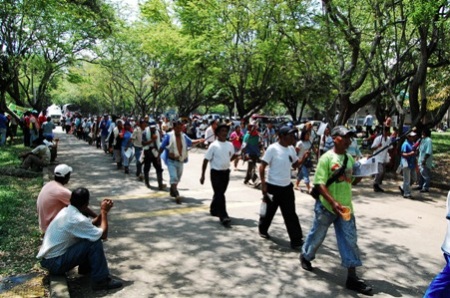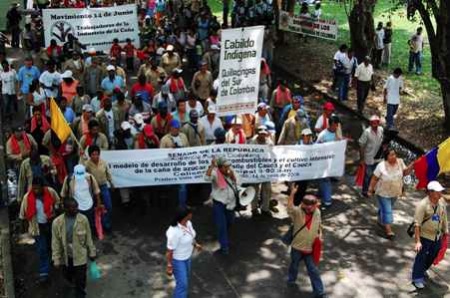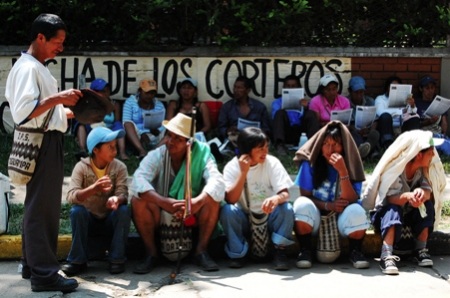On the 25th of October, 2008, I made my way to the University of Valle with Gustavo and Neyla (two friends I had met on the bus on the way to Cali). My reason for wanting to go was to find out further information about the indigenous protests that that were taking place there over the next couple of days. Gustavo and Neyla had come with me for safety reasons, and to also help get me in and out of the university.
The indigenous people had already marched all the way the Panamericana road that links Cali to Popayan for The proposal for a territory of coexistence, dialogue and negotiation of the Piendamo Mary.
The Regional Indigenous Council of Cauca (CRIC), which was founded in 1971, has led the fight for unity in diversity, land, culture and autonomy of indigenous people. Their voice has been quite suppressed though, by the dominant sectors such as landlords and local and national governments, and during the last thirty years, over four hundred local leaders and people from regional indigenous communities have been murdered by security forces.
We walked to the entrance of the university, and the first thing I could see were some of the 82 indigenous communities in the Cauca Department marching on the streets holding flags, and also fake coffins to represent all of the recent deaths. The many different styles and colours of all of the traditional, indigenous people’s clothes were very beautiful.
We entered the uni, so easily that I was a little surprised. There were helicopters flying over head, people cooking traditional foods, and men standing in the street enjoying the spray of cool water from a fire hose. There were more than forty-five thousand people in all, men and women, indigenous peasants and workers, including corteros of sugar cane. I decided to climb up a tree to take some photos in order to get a nice, safe view. The ethnic groups consisted of Paez, Gambians, Kokonucos, Totoro, Yanaconas, EPER Ambalueños, blacks and mestizos. Some were cruising down the streets in colourfully patterned buses, others setting up their tents under the shade of trees… ready to spend the night. People were tying up their communities’ banners as well as anti-military ones, to trees and poles.
The Colombian government promised an open dialogue and social sense, to try to overcome differences with the Indians. But it was always made clear the president would meet with a delegation from the community but not with the crowd for security reasons.
At the University of Valle, three proposals were discussed and debated by the Minga spokesmen among delegates and the national government to finalise the debate demanded by the Social Strength of the Minga Community and with President Uribe.
When Gustavo, Neyla and I tried to leave the university, we were stopped at the gates by indigenous guards and told that we couldn’t leave. This was perhaps because we now had information and photos about what was going on, and they didn’t know whether it was going to be used for the good of their people or not. We managed to sneak out a back way with no problems at all luckily.
The Consejo Regional Indígena del Cauca is committed to taking necessary measures to resolve the emergency social, economic and cultural fields, declared by indigenous peoples del Cauca. Their message is this: Come walk the floor for Colombia, we move to improve as the Minga has a lot of depth and spirituality, today mother nature is united, air and wind are with us.
For more information about the CRIC and their struggle for improved education, health and jurisdiction visit http://www.cric-colombia.org\
Colombia Indigenous Peoples March Protest Students University



Recent Comments